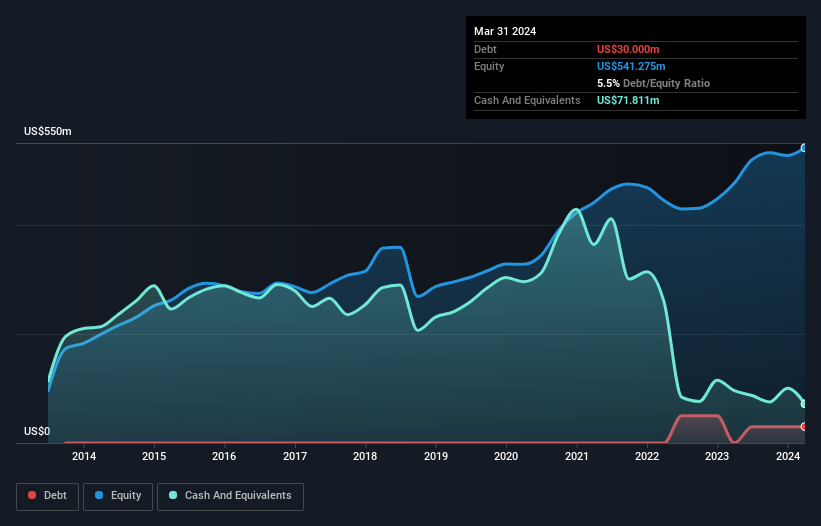- United States
- /
- Interactive Media and Services
- /
- NYSE:SSTK
Is Shutterstock (NYSE:SSTK) Using Too Much Debt?
Warren Buffett famously said, 'Volatility is far from synonymous with risk.' When we think about how risky a company is, we always like to look at its use of debt, since debt overload can lead to ruin. Importantly, Shutterstock, Inc. (NYSE:SSTK) does carry debt. But is this debt a concern to shareholders?
When Is Debt Dangerous?
Debt and other liabilities become risky for a business when it cannot easily fulfill those obligations, either with free cash flow or by raising capital at an attractive price. In the worst case scenario, a company can go bankrupt if it cannot pay its creditors. However, a more usual (but still expensive) situation is where a company must dilute shareholders at a cheap share price simply to get debt under control. Having said that, the most common situation is where a company manages its debt reasonably well - and to its own advantage. When we think about a company's use of debt, we first look at cash and debt together.
Check out our latest analysis for Shutterstock
How Much Debt Does Shutterstock Carry?
You can click the graphic below for the historical numbers, but it shows that as of March 2024 Shutterstock had US$30.0m of debt, an increase on none, over one year. However, it does have US$71.8m in cash offsetting this, leading to net cash of US$41.8m.

How Healthy Is Shutterstock's Balance Sheet?
Zooming in on the latest balance sheet data, we can see that Shutterstock had liabilities of US$433.0m due within 12 months and liabilities of US$54.3m due beyond that. Offsetting these obligations, it had cash of US$71.8m as well as receivables valued at US$94.0m due within 12 months. So it has liabilities totalling US$321.4m more than its cash and near-term receivables, combined.
While this might seem like a lot, it is not so bad since Shutterstock has a market capitalization of US$1.36b, and so it could probably strengthen its balance sheet by raising capital if it needed to. But it's clear that we should definitely closely examine whether it can manage its debt without dilution. While it does have liabilities worth noting, Shutterstock also has more cash than debt, so we're pretty confident it can manage its debt safely.
In fact Shutterstock's saving grace is its low debt levels, because its EBIT has tanked 36% in the last twelve months. When a company sees its earnings tank, it can sometimes find its relationships with its lenders turn sour. When analysing debt levels, the balance sheet is the obvious place to start. But ultimately the future profitability of the business will decide if Shutterstock can strengthen its balance sheet over time. So if you're focused on the future you can check out this free report showing analyst profit forecasts.
Finally, a company can only pay off debt with cold hard cash, not accounting profits. While Shutterstock has net cash on its balance sheet, it's still worth taking a look at its ability to convert earnings before interest and tax (EBIT) to free cash flow, to help us understand how quickly it is building (or eroding) that cash balance. During the last three years, Shutterstock generated free cash flow amounting to a very robust 93% of its EBIT, more than we'd expect. That positions it well to pay down debt if desirable to do so.
Summing Up
While Shutterstock does have more liabilities than liquid assets, it also has net cash of US$41.8m. And it impressed us with free cash flow of US$27m, being 93% of its EBIT. So we don't have any problem with Shutterstock's use of debt. When analysing debt levels, the balance sheet is the obvious place to start. However, not all investment risk resides within the balance sheet - far from it. We've identified 1 warning sign with Shutterstock , and understanding them should be part of your investment process.
If, after all that, you're more interested in a fast growing company with a rock-solid balance sheet, then check out our list of net cash growth stocks without delay.
New: Manage All Your Stock Portfolios in One Place
We've created the ultimate portfolio companion for stock investors, and it's free.
• Connect an unlimited number of Portfolios and see your total in one currency
• Be alerted to new Warning Signs or Risks via email or mobile
• Track the Fair Value of your stocks
Have feedback on this article? Concerned about the content? Get in touch with us directly. Alternatively, email editorial-team (at) simplywallst.com.
This article by Simply Wall St is general in nature. We provide commentary based on historical data and analyst forecasts only using an unbiased methodology and our articles are not intended to be financial advice. It does not constitute a recommendation to buy or sell any stock, and does not take account of your objectives, or your financial situation. We aim to bring you long-term focused analysis driven by fundamental data. Note that our analysis may not factor in the latest price-sensitive company announcements or qualitative material. Simply Wall St has no position in any stocks mentioned.
Have feedback on this article? Concerned about the content? Get in touch with us directly. Alternatively, email editorial-team@simplywallst.com
About NYSE:SSTK
Shutterstock
Provides platform to connect brands and businesses to high quality content in North America, Europe, and internationally.
Undervalued with adequate balance sheet and pays a dividend.
Similar Companies
Market Insights
Community Narratives




